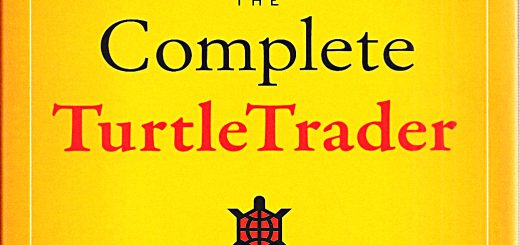The Turtle Traders

Today’s post is the first in a series on The Turtle Traders.
Contents
Why now?
The story of the Turtle Traders is very well known and dates back a very long time.
- So why have I decided to look at them now?
It all stems from Michael Covel’s Little Book of Trading, which is about trend-following.
- It’s a frustrating book, though there are a decent number of trading nuggets hidden with in it.
The plan was to move on to Covel’s more famous book, Trend Following.
- But frankly, I can’t face it at the moment.
It looks like a longer, more detailed version of the first book, so I want to take a breather before tackling it.
Covel also has a book on the Turtle Traders – The Complete Turtle Trader – so I thought that I would take a look at that instead.
As well as the book, we have some other sources:
- The Turtle Rules – published by the “Original Turtles” and distributed free in order to undercut others who were selling the “secret” rules at a high price.
- Curtis Faith’s book The Way of The Turtle (Curtis was one of the Turtles).
- A few articles I’ve collected on the topic.
- My notes from the last time I looked at the system, six years ago. (( Back in 2012, before I started this blog ))
We’ll start today with my notes.
System trading
The Turtle Rules are probably the most famous trading system ever – or at least, the system most-often discussed in public.
- Over the next few posts, we will examine this system in detail, and go on to see how it can be applied (in a slightly simplified version) by a UK private investor.
Most successful traders use a mechanical system.
- Let’s start by looking at what goes into one.
A mechanical trading system must answer all of the questions a trader asks himself, with the aim of totally automating the decision process (if not the actual execution of trades).
This in turn makes it easier for the trader to behave in a consistent and unemotional way.
- If the system has a successful track record, the trader can be confident that it is worth sticking with through a losing streak.
A system will involve up to six key features:
- Markets – what to trade
- Position Sizing – how much to buy or sell, so as to minimize risk
- Entries – when to buy or sell
- Stops – when to close a losing position
- Exits – when to close a winning position
- Tactics / Execution – how to buy or sell
System Features
Most trading systems are trend-following, and the Turtle Rules are no exception.
- The aim is trade enough markets so that there are enough trends to follow.
- Illiquid and non-trending markets are to be avoided.
Position-sizing has two aspects:
- First, markets of different volatilities must be matched so that the risk in each is equivalent (by using different sizes in different markets), and
- Second, the overall risk to the portfolio from each trade must be limited (typically to 1% or 2% of the portfolio).
The risk-matching across markets is equivalent to the diversification effect in passive asset allocation.
Cutting losses is one of the most important aspects of successful trading.
- Actually placing stop loss orders is not necessary, but a defined quitting point is needed before the entry trade is placed.
Running winners is another key concept, and the system must not exit too soon.
- For most traders, the majority of their profits come from a minority of extremely profitable winning positions.
The Turtle Traders
In the 1980s, Richard Dennis and William Eckhardt trained 14 “turtles” to trade successfully (80% compound gains over more than 4 years).
The genesis of the project was a bet between the two men over whether great traders were born or made (much like the premise of the movie Trading Places).
Subsequently – and after a 10-year embargo had expired – some of the turtles found they could make more money by selling courses and the trading rules that Dennis gave them than by trading.
- To prevent this, another group of turtles, lead by Curtis Faith, published the rules online for free.
Faith believed (and indeed Dennis had previously stated) that the publication of the rules would not lead to many people learning to used them successfully.
- They both felt that confidence and consistency were more important than rules.
Dennis gave the turtles the confidence to stick with the rules even through losing periods.
- He also gave them large amounts of money to play with.
In February 1984, after only six weeks of training, the 13 turtles were given trading accounts of between $500k and $2M.
They were called turtles after a quote from Dennis “We are going to grow traders just like they grow turtles in Singapore.”
Turtle Markets
The turtles traded futures contracts on the Chicago and New York commodities exchanges.
- They had large trading accounts and needed very liquid markets.
- All markets were traded except for grains (where Dennis himself was already trading his full position limits) and meats (where there was a
corruption problem).
The markets included:
- Bonds – US 10 year and 30 year bonds and 90-day bills
- Agriculture – Coffee, Cocoa, Sugar and Cotton
- Currencies – the dollar against the Pound, Yen, Mark, Swiss and French Francs and the Canadian dollar
- Stocks – S&P-500
- Metals – Gold, Silver, Copper
- Energy – Oil, Heating Oil, Gas (petrol)
Most of these markets are still available (the Mark and French Franc have been subsumed into the Euro).
A UK Private Investor would probably begin with spread bets, and might substitute UK-focused options for US ones (there are timezone advantages, for a start):
- Equities – FTSE-100 and probably S&P-500 too
- Currencies – USD/GBP and GBP/EUR
- Commodities – Gold and Oil, perhaps an agriculture basket
- Bonds – UK and US 10-year bonds
That gives 9 markets against the 20 of the turtles.
- This is perhaps a disadvantage, but not every Turtle had to trade every market.
It should be simple to add the other two metals and some of the other five commodities if we decided that more markets would help.
- We could also add other stock indices (Europe and Japan) and other bond durations.
It should be possible to get back to 20 markets if we need to.
Turtle Position Size
The Turtles used a “volatility-based constant percentage risk position- sizing algorithm”.
- Put more simply, N was a precursor of Average True Range (ATR).
N was the 20-day exponential moving average of the True Range (ie. ATR), and was used to measure volatility.
Today’s True Range, TR = Max (H-L, H-PDC, PDC-L)
Where PDC is the previous day’s close.
- This is basically today’s range with the overnight gap (if any) added back.
N = (19*PDN + TR) / 20
PDN is the previous day’s N, and must be initially calculated from a simple 20-day average of TR.
- The turtles recalculated N once per week.
The Unit Size for a market was chosen such that N matched to 1% of the portfolio equity.
Faith used an example from the heating oil market to illustrate:
- The market volatility was 1.41% (N=0.0141)
- The contract size was 42,000 gallons, giving a dollars per point of 42,000.
- Thus the Dollar Volatility of a contract was N x dollars per point = 42,000 *0.0141 = $592.2
So for an account of $1M:
- Unit Size = (1%* 1,000,000) / 592.2 = 10,000 / 592.2 = 16.89
- This Unit would be rounded down to 16 contracts.
We’ll look at this in more detail in future posts, but for now, let’s assume we want to place a spread bet on a market where the daily volatility (ATR) is 1%.
- Let’s also assume that our account size is a more modest £25K.
- Thus 1% of the account is £250.
With the FTSE-100 currently trading around 7,300 the 1% daily volatility is 73 points.
- At £1 per point, the pound volatility is £58.
- Thus the Unit Size would be 250/73 = 3.42, which we would round down to £3
per point.
For GBP/USD trading around $1.31, daily volatility is 1.3 cents and the unit size would be 250/1.3 = 192.3, rounded down to £190 per cent.
Market limits
These units were used limit risk across markets.
There were four levels:
- 4 units per market
- 6 units across “closely correlated markets” (eg. gold and silver)
- 10 units across “loosely correlated markets” (eg. All commodities, all currencies)
- 12 units in a single direction (long or short)
If we stick to the core nine markets, we won’t have most of the “closely correlated markets”.
- It might be prudent to average the “closely” and “loosely” limits, and use a limit of 8 units across markets of any level of correlation (let’s call these Categories).
Changing account size
The account size would be adjusted on an annual basis (the Turtles were given more money to play with each year).
- This would automatically lead to the unit size changing.
Unit sizes were also modified when losses were taken.
- After a 10% loss of capital, a penalty was applied such that the unit size decreased by 20%.
So for a $1M account:
- 10% loss to $900K, trade as if account is now $800K
- further 10% loss of nominal $800K to $820K, trade as if account is now $640K
With a spread-betting account, the size of the account changes in real time.
- So unit sizes will be calculated from live data at the time of the trade.
Turtle entries
The turtles used entry signals based on the Channel Breakouts system by Richard Donchian.
- Two signals were used, one based on a 20-day breakout and one on a 55-day breakout.
A breakout simply meant that the high of the previous 20 or 55 days had been exceeded on an intra-day basis.
- With opening gaps, the turtles traded if the open was through the breakout price.
20-day breakouts were ignored if the previous signal (whether taken or ignored) would have produced a winning trade.
- Thus we must examine the exit and stop criteria for such a trade.
A profitable exit could not take place before 10 trading days had elapsed.
- The losing stops would be placed 2N (2ATR) below the entry price (see below).
- Thus a losing trade was one where the market moved 2N against the position before a profitable 10-day exit.
The 55-day breakout signal was always taken, whether or not the previous signal would have been winning.
One Unit positions would be added to at 1/2 N intervals from the fill price of the initial entry, up to a maximum four Units.
- None of this needs changing at this stage.
Stops
The maximum loss per position (usually known as R, the money at risk) was deemed to be 2%.
- Since a 1N price movement represented 1% of the account, stops were set 2N (2ATR) away from the entry point.
When additional units were added to a position, stops would be adjusted to be 2N away from the last entry.
- Price skidding in fast markets and opening gaps would cause slight variations from this rule.
A second approach to stops was also used:
- stops were placed at ½ N from entry, and not moved when extra Units were added.
If a particular Unit was stopped out, it would be re-entered if the market reached its entry price once more.
- This “Whipsaw” method produced more trades and more losses but a better profitability ratio.
We’ll begin by using the first (simpler) stops method only.
Exits
The turtle system was designed to avoid getting out of winning trades too early.
Since prices rarely move in a straight line, the Turtles were prepared to watch early profits halve or even evaporate in order to catch the big trends.
- Most of the Turtles’ trades were losing, so the winning trades had to make up for them.
Two exits were used, to match the two entry signals.
- For a 20-day breakout entry, a 10-day breakout against the position was used to exit (eg. a 10-day low for a long position).
- For a 55-day breakout entry, a 20-day breakout against the position was used.
No changes are needed here.
Tactics and execution
- The turtles did not use real stop orders, but “mental” stops instead.
- This was partly because the size of their trades could move the market, and they did not want to signal their positions.
- They used limit orders to minimize price slippage.
- They did not trade in “fast” markets, but waited for prices to stabilize and liquidity to return, even if their next action would be to exit the market.
- They actioned entry signals across markets as they arrived, until all of the Unit position limits were reached.
- With simultaneous signals, those in the strongest / weakest markets were
actioned first. - Strength was typically defined by reference to charts, perhaps in terms of how many N the market had moved since the original breakout signal.
- With simultaneous signals, those in the strongest / weakest markets were
- They did not rollover futures contracts into the next month unless the price action in the new month justified an entry itself.
No changes are needed here at this stage.
- We’ll see later how easy this approach is to implement in practice.
That’s it for today.
- I’ll be back in a couple of weeks with a look at the original Turtle Rules pamphlet.
Until next time.


















